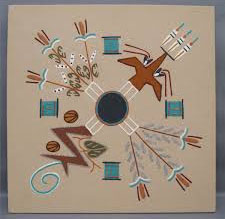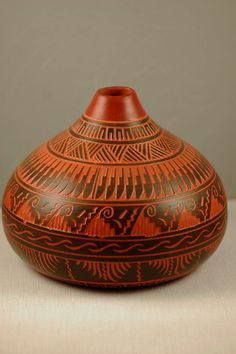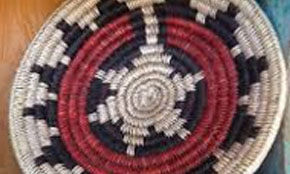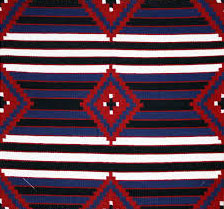Generational Art
 Introduced by the Spaniards & Mexicans around the middle of the 19th Century, Navajo silversmiths obtained metal by melting down American silver dollars or Mexican pesos.
Introduced by the Spaniards & Mexicans around the middle of the 19th Century, Navajo silversmiths obtained metal by melting down American silver dollars or Mexican pesos.
It’s believed that Navajos began working with turquoise after returning from Fort Sumner, New Mexico in 1868. Aside from its ornamental value, turquoise is especially important to the Navajo people because of the ceremonial significance.
Because of the beauty of Navajo jewelry, other countries make copies and pass it off as Navajo. Don’t assume anything. Always ask if the silver is sterling, if the turquoise is genuine, and if it is a Navajo made. Federal Law regulates statements of authenticity.
 Sandpainting – an other unique and symbolic art form originating with the Holy People, was and still is primarily ceremonial purposes. Sandpaintings represent an array of ceremonies and sacred songs. These ceremonies are held for Navajo individuals and their family members only.
Sandpainting – an other unique and symbolic art form originating with the Holy People, was and still is primarily ceremonial purposes. Sandpaintings represent an array of ceremonies and sacred songs. These ceremonies are held for Navajo individuals and their family members only.
The art of sandpainting in the present day has been transformed into art on board by using sand to design pictures for public consumption. If Navajo deities are used, specific elements of the deities are eliminated before they are sold to the public.



 The earliest type of Navajo pottery excavated were of utilitarian ware dating from 1500-1700. After the Long Walk in the 1860’s, manufactured ware was made readily available by trading posts and this caused a tremendous slowdown in Navajo pottery making. Pottery was then produced mainly for ceremonial use.
The earliest type of Navajo pottery excavated were of utilitarian ware dating from 1500-1700. After the Long Walk in the 1860’s, manufactured ware was made readily available by trading posts and this caused a tremendous slowdown in Navajo pottery making. Pottery was then produced mainly for ceremonial use. Navajos believe that the Holy People who originated with First Man and First Woman, made baskets for ceremonial purposes. Each part of the basket has a special significance. Today, apart from their ceremonial usage, Navajos also use baskets as household displays.
Navajos believe that the Holy People who originated with First Man and First Woman, made baskets for ceremonial purposes. Each part of the basket has a special significance. Today, apart from their ceremonial usage, Navajos also use baskets as household displays. Navajo rug weaving is recognized throughout the world, not only because of its aesthetic qualities, but also because of its unique stylistic changes. Navajo women believe the art of weaving was taught by Spider Woman, who constructed a loom according to directions given by the Holy People. Today distinct styles of rugs identify designs woven in different regions: Two Grey Hills, Ganado, TeecNosPos and Crystal – all famous world wide.
Navajo rug weaving is recognized throughout the world, not only because of its aesthetic qualities, but also because of its unique stylistic changes. Navajo women believe the art of weaving was taught by Spider Woman, who constructed a loom according to directions given by the Holy People. Today distinct styles of rugs identify designs woven in different regions: Two Grey Hills, Ganado, TeecNosPos and Crystal – all famous world wide.